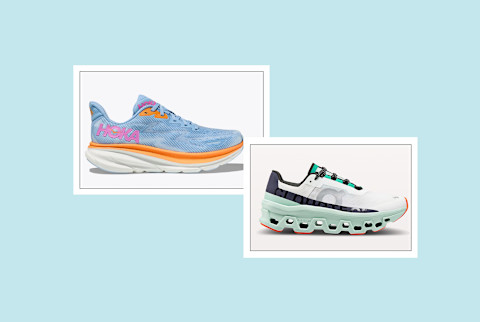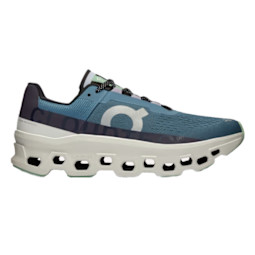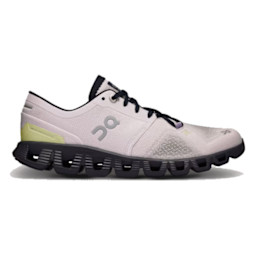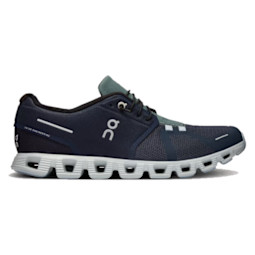On Cloud vs. Hoka: How To Choose The Best Shoes For You, Per Podiatrists

If you ask any experienced runner about their favorite shoes, two of the styles that you'll hear about most often are On Running Shoes and Hoka.
While both have brands have plenty of fans—including podiatrists—which one is better for running?
Keep reading to learn whether On or Hoka will be a better fit for you.
What is Hoka?
Hoka is celebrated for its maximalist approach to cushioning that has earned the podiatric APMA Seal of Acceptance, indicating the shoes promote good foot health.
The brand was founded in 2009 by two avid runners, Jean-Luc Diard and Nicolas Mermoud, who aimed to create a shoe that would provide enhanced cushioning and support for runners, particularly those tackling longer distances.
Fun fact: Even if you've had six pairs, you probably don't know the brand's name is derived from the Maori language. "Hoka one one" means to "fly over the earth." This name reflects the brand's commitment to creating shoes that allow runners to glide effortlessly and comfortably over various terrains.
Plenty of doctors and podiatrists have recommended Hoka for its beneficial design and enhanced cushioning. Tim Dutra, DPM, M.S., MHCA, says, "Hoka offers a variety of shoes with a wide range of cushioning and support and width options, and Hoka shoes are a favorite of runners, walkers, and hikers."
Maybe it's the brand's Meta-Rocker technology that employs a curved sole geometry for a smooth and efficient gait cycle, or maybe it's the maximalist cushion that reduces the impact on joints and improves overall gait dynamics.
Hoka shoes deliver ample shock absorption and reduce impact on joints, which is a favorable experience for many of us.
Who should try Hoka?
Who should try Hoka?
Hoka shoes cater to runners who prioritize maximal cushioning and comfort. These shoes are popular among long-distance runners, ultramarathoners, casual runners, and walkers seeking relief from joint pain or injuries.
Sharkey says, "Hoka has a wide selection of shoes in its lineup that are really amenable to most foot types and most activity types." Hoka's emphasis on cushioning and stability makes its shoes a go-to choice for those looking to reduce the impact of running on their joints.
If you're seeking shoes that excel in shock absorption so you can tackle running long distances without feeling fatigued, Hoka could be a good option to try. NYC podiatrist and founder of Dr. Brenner's RX Foot Care Hillary Brenner agrees.
"Hokas are good for long-distance running because it's a maximalist shoe (meaning it has a high-heel stack) and is made of EVA, which is a foam that helps with shock absorption," Brenner says.
People who walk or stand for long periods of time can also benefit from the shoe's maximalist approach to cushioning.
RELATED: Best Shoes For Arthritic Feet + What Shoes To Avoid
Who shouldn't try Hoka?
Who shouldn't try Hoka?
Podiatrists recommend Hokas for many different reasons, though they may not be suitable for everyone. When shoe shopping, it's important to address your foot shape, activity, and shoe preferences.
You may want to consider alternatives to Hoka if you align with any of the below:
- Minimalist shoe fans: If you prefer a minimalist running shoe with less cushioning and a lower profile, HOKA might not align with your preferences. Its maximalist cushioning approach may feel excessive to those who prefer a more natural or minimalist feel underfoot.
- Sprinters: Due to the enhanced cushioning, HOKA may not be the best choice for very short and fast-paced races where a lightweight and low-profile shoe could offer a competitive advantage. With its emphasis on cushioning, HOKA might not be the best choice for runners looking to sprint in shorter races.
Hoka pros & cons
Hoka shoes offer several pros that make them so popular among all kinds of people, especially those who prioritize comfort and cushioning. Here are some key advantages:
Pros
Pros
- Maximal cushioning: Known for their generous midsole cushioning, Hoka provides superior shock absorption. This cushioning can be especially beneficial for those tackling long distances or dealing with joint pain, as it reduces the impact on the body.
- Reduced fatigue: The plush cushioning in Hoka shoes can help reduce fatigue during extended runs or walks. Runners often report feeling less soreness and discomfort after completing long distances in Hoka.
- Meta-rocker technology: Hoka's Meta-Rocker design, characterized by the curved sole geometry, promotes a smooth and efficient heel-to-toe transition. This can improve running efficiency and reduce the risk of injury by encouraging a natural and smooth gait cycle.
- Joint protection: The enhanced cushioning of Hoka shoes can be particularly beneficial for runners with joint issues or those seeking extra protection during their runs. The cushioning helps absorb shock and reduce the stress placed on joints.
- Injury prevention: The cushioning and support offered by Hoka shoes may contribute to a lower risk of injuries such as stress fractures and joint pain.
- Adaptive fit: Many Hoka models are designed with an adaptive fit, meaning they contour to the shape of the foot, providing a snug and supportive feel without causing discomfort or pressure points.
- Durability: Despite maximal cushioning, Hoka shoes are known for their durability, maintaining their cushioning and structural integrity even after extensive use.
- Sustainability: Hoka claims that over 97% of its footwear styles contain at least one preferred material (a recycled, renewed, or naturally sourced material). The brand's California distribution center is set to be a zero-waste facility by the end of 2023.
Cons
Cons
- If you're used to lower-profile shoes, transitioning to highly cushioned shoes like Hokas can take time. Podiatrists recommend gradually introducing rocker bottom shoes to your training routine to allow your body to adapt to the extra cushioning. One study shows that those who are new to running may be at an increased risk of injury with this style of maximalist shoes.
- While Hoka offers an adaptive fit for many runners, the fit might not be suitable for all foot shapes and sizes. Some individuals find that Hoka shoes don't provide the snug fit they desire. "Choosing the right model (based on your foot type) is most important," emphasizes Sharkey.
- Some runners with ankle instability or those who need a shoe with a lot of ankle support might find Hoka's higher sole stack height to be less stable. This is especially relevant if you're accustomed to shoes with a lower profile that provides a closer connection to the ground.
Our top picks from Hoka
Materials:
Recycled polyesterRecycled nylonRubberSizes available:
Half sizes available5-12Colorways:
17Drop:
5mmWeight:
7.3 ozReturn policy:
30 daysVaries by retailerSharkey recommends the Clifton 9 for those with flat feet who need enhanced stability in their shoes. Its meta rocker will make every step feel bouncy and smooth. Plus, its’ wide toe box makes this a great pick for people with wide feet. The knit material molds to the shape of your foot to eliminate sliding and overpronation, making this a great pick for a variety of foot types. They’re made for all seasons, too. The shoes are breathable and lightweight, yet supportive and stabilizing.
It’s hard to say who shouldn’t try this best-selling Hoka model, which is why you’ll find the Clifton 9 in our roundups of the best sneakers for standing all day, best shoes for arch support, best shoes for knee pain, best gym shoes, and the best shoes for high arches.
Materials:
Recycled polyesterRubberSizes available:
Half sizes available5-12Colorways:
19Drop:
4mmWeight:
8.9 ozReturn policy:
30 daysVaries by retailerThis is Hoka's most cushioned shoe, and also one of the best maximalist running shoes out there. You can expect tons of bounce from this shoe as the tall stack height is designed to absorb impact with every step.
Despite the max cushion of this shoe, wearers are surprised by how lightweight it feels.
Mindbodygreen tester, Caitlyn Martyn, swears by these shoes and loves the height and bounce they provide. “It almost feels like from the moment you lace up, your shoes do all the running for you”, she writes in our roundup of the best rocker bottom shoes.
Sizes available:
Half sizes available5-12Colorways:
12Drop:
5mmWeight:
7.6 ozThis shoe is a direct recommendation from Sharkey for people with flat feet. “Hoka has an edge on the market for those with flat feet needing enhanced stability with the Arahi," she says. "Its active foot frame is designed to cradle the foot for stability and comfort.”
We’ve also called the Arahi out in our roundup of the best shoes for flat feet, per podiatrists advice to reduce or prevent overpronation. A unique J-Frame design aims to do just that, while keeping the shoe lightweight and flexible.
A mesh lining, compression-molded foam insole, and built-in meta-rocker helps make for smoother wear and better forefoot support.
What is On?
On Cloud is known for its innovative running shoes that emphasize lightweight design, responsive cushioning, and unique sole technology.
The brand was founded in Switzerland in 2010 by Olivier Bernhard, Caspar Coppetti, and David Allemann, who sought to create running shoes that would provide a comfortable and natural running experience.
To this day, all products are Swiss-engineered in the On Lab, with a low carbon footprint from alternative materials.
The hallmark feature of On Cloud shoes is the brand's CloudTec technology, which involves individual pods or "clouds" integrated into the sole of the shoe.
These clouds are designed to provide cushioning and support during both landing and push-off phases of running. When the foot strikes the ground, the clouds compress to absorb impact, and when the foot pushes off, the clouds firm up to aid in propulsion.
What's more, the shoes are designed to adapt to the runner's gait and provide a responsive feel, promoting a smooth and comfortable stride.
On Cloud shoes are lightweight, which can be particularly appealing to runners who prioritize agility and a more minimalistic feel.
Plus, with a range of shoe models tailored to different running preferences, terrains, and styles.
Who should try On?
Who should try On?
On Cloud shoes are designed to appeal to a wide variety of people, particularly those who value lightweight design, responsive cushioning, and versatility in their footwear.
"OnCloud is a shoe company tailored to runners. Those looking for extra cushioning and an edge to up the speed in their running should look to OnCloud," Sharkey explains.
The brand says its shoes are great for casual runners who want a comfortable and lightweight option, and also a top choice for short and mid-distance runners who benefit from responsive cushioning for quick bursts of speed and agility.
Beginners in the running world often find On Cloud shoes to be a comfortable and approachable option. The lightweight and cushioned design can help ease the impact on joints as new runners adapt to the activity.
Lastly, if you prioritize sustainability, you'll love that this company does too. You can learn all about its alternative materials, zero-waste shoes, and engineer partnerships here.
RELATED: Best Shoes for Wide Feet Of 2023, Podiatrist Reviewed
Who shouldn't try On?
Who shouldn't try On?
While On Cloud shoes have gained popularity for their innovative design and comfort, it's important to note that like any brand, they might not be the best fit for everyone.
Runners should consider individual preferences, running goals, and biomechanics when selecting a pair of running shoes. Trying on various models and understanding the specific features of On Cloud shoes will help you make an informed decision based on your individual needs.
Below are a few scenarios in which you might want to consider alternatives to On Cloud shoes:
- Long-distance runners: While comfortable and lightweight, On Cloud shoes do not provide the same level of cushioning and support needed for every long-distance runner. Some might require more substantial cushioning to protect your joints during extended runs.
- Individuals with specific support needs: Runners who require specific types of support, such as stability or motion control, might not find the necessary features in On Cloud shoes, which tend to emphasize responsiveness and lightweight design.
- Runners with pronation concerns: If you have severe overpronation or other gait-related issues, you might require a shoe with more structured support than what On Cloud shoes typically offer. When in doubt, consult with a podiatrist.
On pros & cons
It's important to consider both the pros and cons of On Cloud shoes in alignment to your individual preferences, running goals, and biomechanics.
Pros
Pros
- Lightweight design: On Cloud shoes are known for their lightweight construction, making them comfortable and agile for various types of runs.
- Responsive cushioning: The CloudTec technology provides responsive cushioning, offering a balance between comfort and ground feel.
- Versatility: On Cloud shoes are versatile and suitable for a range of activities, from casual runs to gym workouts and cross-training.
- Adaptive fit: Many On Cloud models feature an adaptive fit that contours to the shape of the foot, providing a comfortable and secure feel.
- Quick transitions: The responsive cushioning and design of On Cloud shoes contribute to quick and efficient transitions during runs.
- Sleek aesthetic: On Cloud shoes often feature modern and stylish designs that appeal to those who value aesthetics.
- Breathable upper: Many models come with breathable uppers, keeping feet cool and comfortable during runs.
- Sustainability: The brand describes its dedication to sustainability as "Creating a future where every On product is fossil-free and engineered for circularity." As such, On Cloud is pioneering technologies to create a positive impact on communities and the planet by creating high-performance products with the lowest possible footprint.
Cons
Cons
- Not APMA certified: The American Podiatric Medical Association (APMA) Seal of Acceptance recognizes products that have been found beneficial to foot health. To earn the seal, each product is reviewed by a group of APMA podiatrists to ensure it promotes foot health. They have not awarded the Seal to On Cloud.
- Limited cushioning for long distances: On Cloud shoes might not provide enough cushioning for runners who frequently tackle very long distances, potentially leading to discomfort or fatigue.
- Minimal support: Runners who require specific support features, such as stability or motion control, might not find adequate support in every On Cloud shoe.
Our top picks from On
Best supportive: On Running Cloudmonster

Materials:
Recycled polyesterFoamSizes available:
5-11Half sizes availableColorways:
14Drop:
6mmWeight:
8.11 ozReturn policy:
30 daysVaries by retailerFeaturing the brand’s thickest CloudTec® cushioning, On’s CloudMonster is a highly supportive shoe. As the name suggests, the shoe offers a sensation similar to running on fluffy cumulus clouds, which I (the writer) can personally verify, since they are my preferred shoe choice for running. The monstrous Cloud elements meet an ultra powerful Speedboard® which result in extremely soft landings and maximum rebound.
This footwear amplifies the emphasis on cushioning while still maintaining a lightweight feel. I'm a long-distance runner who grapples with discomfort in the hips, knees, and joints—and the CloudMonster has been a savior for my joints, both during and after runs. It even empowers me to cover greater distances than other shoes allow.
The road running design is oriented forward, supplying ample momentum to propel you through your run. The only downside is that there’s not a ton of ankle support or stability for pronation. If that’s a concern, you might be better off with a different pair.
Best for cross training: On Cloud x 3

Sizes available:
5-11Half sizes availableColorways:
11Drop:
8mmWeight:
7.1 ozReturn policy:
30 daysVaries by retailerPerfect for those looking to jump from one activity to the next, this shoe is made for everything. This shoe combines a sleek, modern design with next-level technology that delivers a lightweight, responsive, and ultra-reactive cross trainer.
The Cloud X 3 is built to provide an exceptional experience for those who value responsiveness and support. Though lightweight, the shoe features On's signature CloudTec technology, which consists of individual cloud-like pods in the sole. These pods offer a unique combination of cushioning and responsiveness, ensuring a comfortable landing and an energized push-off during each step.
Best for standing all day: On Cloud 5

Sizes available:
5-11Half sizes availableColorways:
14Drop:
7mmWeight:
7.1 ozReturn policy:
30 daysVaries by retailerThis On-fan favorite is re-engineered with 44% recycled content, improved fit and even more comfort than the On Cloud 4. Crafted for extended comfort throughout the day, it features a breathable antimicrobial mesh upper and a patented zero-gravity Cloudtec cushioning to ensure a gentler impact with each stride.
What truly distinguishes this shoe is its distinctive speed-lacing mechanism, so you won’t have to worry about your laces coming loose or undone. For those who lean toward a more traditional shoelace experience, the box also includes that alternative.
There’s also a waterproof version of the Cloud 5 if you plan to take your workouts to the outdoors.
On vs. Hoka: Comparing the cost
Winner: On
On running shoes typically fall within a midrange price category, making them more accessible to a broader group. Prices for On shoes start around $100 and can go up to around $200 for certain specialized models with advanced features.
HOKA shoes generally start between $100 and $130 for basic designs. Premium models with advanced cushioning and features can range from $130 to $250 or higher.
It's important to note that both brands often release new models and updates to existing models, which can affect pricing. When considering the cost, take into account the features and benefits each shoe offers, and choose the one that aligns best with your running preferences and needs.
On vs. Hoka: Comparing the sustainability
Winner: On
Both Hoka and On have sustainability efforts, but On comes out on top when it comes to sustainability.
On's innovation team is always at work investigating lower-impact, fossil-free materials: advanced recycled sources, carbon-emissions-based materials, and bio-based materials. The brand even partnered with the circular thermoplastics experts Borealis, carbon recycling specialists LanzaTech, and engineering leaders Technip Energies to use captured carbon emissions in the CleanCloud™ foam.
With this new EVA foam, On is aiming not just to reduce carbon emissions but to turn carbon emissions into performance products.
The brand even has a program that allows you to send back old shoes every six months to be recycled. The best part? You'll get a new recycled pair sent back to you in its place.
Hoka is also transparent about its efforts, sharing plans to reduce energy usage in its footwear by 25% per shoe by 2030 and to make its distribution center a zero-waste facility by the end of 2023.
Over 97% of Hoka's footwear styles contain at least one sustainable material (a recycled, renewed, or naturally sourced material)—and the company is aiming to use renewable or post-consumer resources in 55% of all co-polyester fibers in its footwear and 70% in apparel and accessories by 2030.
On vs. Hoka: Key differences
There are a few key differences between On Clouds and Hokas. First: the cushioning systems.
On Cloud shoes are known for their CloudTec technology, which features individual pods or "clouds" in the sole that provide a balance of cushioning and responsiveness. The focus is on lightweight design and quick transitions. Cloud shoes are often favored by runners who appreciate a more agile and natural feel underfoot.
In contrast, Hoka shoes are recognized for their maximalist cushioning, offering generous midsole cushioning that absorbs impact over longer distances. The Meta-Rocker technology promotes a smooth heel-to-toe transition. Hoka shoes are often chosen by runners seeking enhanced comfort and joint protection during extended runs.
When it comes to weight and profile, On Cloud shoes are designed with a lightweight profile, often targeting runners who value agility, versatility, and quicker transitions. Hoka shoes tend to feel bulkier or heavier due to their maximal cushioning; however, weight comparisons between the two brands also depend on the model and size.
Sharkey explains the difference between the technology in a simple breakdown:
Hoka technology focuses on:
- Meta Rocker: helps with energy conversion from heel strike to toe off
- Cushioned midsole: for better shock absorption
- Active foot frame: meant to cradle the foot for stability and comfort
On Cloud technology focuses on:
- CloudTec: signature cushioning system that functions to absorb impact and reduce strain and adapts to each individual running style
- MissionGrip: traction for different surfaces
- Helion: super foam that functions to absorb shock on a variety of surfaces
- Speedboard: helps harness momentum and increase speed
How to choose between On Cloud vs. Hoka
Ultimately, the choice between On Cloud and Hoka depends on your shoe preferences, physical activities, and biomechanics.
Podiatrists recommend considering factors such as foot shape, cushioning preferences, terrain, distance, fit, and individual comfort when deciding which brand and model best align with your running needs.
"Both Hoka and On Cloud are great shoe companies," says podiatrist Anne Sharkey. "Hoka has an edge on the market for those with flat feet needing enhanced stability with the Arahi and Clifton models, while On Cloud is going to be great for anyone with neutral-high arches that are looking for a great running shoe with responsive cushioning. They are also a great option for all foot types for day-to-day activity."
FAQs
What compares to On Cloud shoes?
On Cloud's innovative design and technology are one of a kind and aren't directly comparable to other shoes.
Who are Hoka's biggest competitors?
Brooks, Altra, and Saucony are the major podiatrist-approved shoe companies in competition with HOKA.
Why do podiatrists recommend Hoka?
Hoka earned the podiatriac APMA Seal of Acceptance, which guarantees that the shoe design promotes foot health.
Do Hokas wear out fast?
Hoka shoes are highly durable and can withstand multiple terrains. Running shoes should be replaced every 300 miles, per podiatrist guidelines.
Hoka vs. On Cloud for plantar fasciitis.
We called out the OnCloud Nova as the best shoes for plantar fasciitis in our best shoes for nurses roundup.
The takeaway
Though both brands are liked and recommended by podiatrists, only Hoka has the APMA Seal of Approval—and it's a better choice if you're looking for a rocker bottom shoe with maximum cushioning.
On Cloud, however, wins from a sustainability standpoint and is favored by those with high arches who are looking for a lightweight shoe that still doesn't skimp on support.
If you're interested in seeing shoe options beyond Hoka and On Cloud, check out our roundup of the best gym shoes for women.



